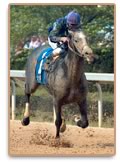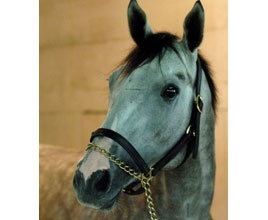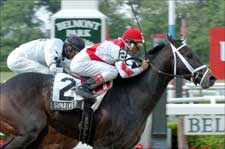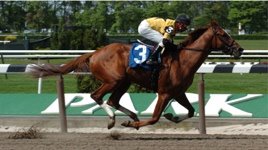Several months ago, I got tired of public handicappers making my selections for me. Up until then, I’d open up the Daily Racing Form (DRF) and see who the consensus selection was, or I’d listen to the guys on the “Thoroughbred Los Angeles” radio show, and write down all their “hot picks.” Sure, they sometimes had good information about a horse, but more often that not, they were wrong. And when they were right, the public had bet their “best bets” down into a lousy deal. As the saying goes, “There’s not a man alive who can pay the rent at 4-5.” Not only did I want to have a little more cash in my pocket as I drove past Laffit Pincay Jr. Drive on the way home, but I also wanted to feel like I was more in control of my own bets. I didn’t mind listening to other people’s advice if it confirmed my opinion; I just didn’t want them making up my mind for me.
What the non-horse player doesn’t understand is: It’s not really about the gambling. We do it for the same reason we do the Sudoku or the crossword puzzle. To prove to ourselves how smart we are. I don’t want Brad Free telling me the answer to 24 Down—I can figure it out for myself. And if I can’t, I have no business sitting in the grandstand.
Part of what I wanted to figure out was: What made the favorites the favorites? (I mean, other than the fact that they were deemed so by the house handicapper.) Who would I pick if I didn’t have anyone telling me whom to pick? I wanted to be able to approach the DRF the way a pro does. To get started, I purchased a copy of Betting on Horse Racing for Dummies, by Richard Eng. Eng is a public handicapper for the Las Vegas Journal-Review, and his book is an excellent primer on every aspect of the process. Not only did it introduce me to some very intelligent betting angles, but even more importantly, it taught me how to decipher the past performance lines (PPs), and allowed me the confidence to create my own method for handicapping a race. At least now when I lose a race, I know I screwed it up all on my own.
One of the major concepts presented by Eng is the “pace scenario” of a race. When it comes down to it, a horse is still a horse. Whether by genetics or the way they’ve been trained or even by personal inclination, they have a predisposition to run a race a certain way. They are herd animals that want to either lead the pack or follow it, and even the best jockey’s influence on how he runs a race is limited. A simple example of this is: If there are a lot of speedy horses in the race, they are likely to burn each other out competing for the lead right away. By the end, they’ll be left gasping for air, and (without opposable thumbs or the natural ability to gulp down a power bar during a race) that grueling pace can leave the door open for a more patient horse to charge home and win the race at the end.
On the other hand, if the race is full of a lot of slow-'n'-steady types, a speed demon can get out front early and just keep going and win the race gate to wire, kicking dirt in everyone’s face. An excellent example of that was Sinister Minister’s performance at Keeneland in mid-April.
At Hollywood Park last year, I noticed a feature they used to include in the programs. It was called PacePals, and it used various icons to designate the running styles of the horses. It was a little like the signs in the Chinese zodiac. The four basic styles were: Rabbit (early speedster, sets the pace); Fox (runs just off the pace); Hound (trails but still stays within range of the main pack); and Turtle (looks like he’s completely out of the race until he pours it on at the top of the stretch).
I often went home broke after those Friday night races, and I’d sit at my kitchen table staring at my racing program wondering what I had done wrong. What clues in the program had I failed to discern? Which handicappers should I have trusted? Which jockeys, stats, colors of the horses? But none of them were dependable. But I did notice that a lot of the time, those PacePals indicators turned out to be pretty good. It was kind of embarrassing handicapping with "Tiny Toons," but it ended up being more trustworthy than the opinions of the entire DRF staff. It wasn’t until I read Eng’s book that I understood why pace played such a huge role in determining a horse’s performance.
But then I started wondering if I could even trust the PacePals people to correctly tell me who was a tortoise and who was a hare. As part of my project for handicapping self-sufficiency, I started determining it for myself, based on the data in the DRF’s PPs. I developed a ritual that I performed the night before each day of racing. I completely ignored the public handicappers until I was finished making notations on the PPs. My system required a cryptic combination of circles, dashes, underlines and dots, focusing on key statistics on the lines of a past race. Basically, underlines are okay; circles are very good; and heavy circles are excellent.
I made a circle every time a horse finished in the top three, and I underlined every time the horse ran the exact same distance or surface that is being run in the race at hand. I circled the winning time of a horse at today’s distance and surface, and calculated my horse’s time based on the number of lengths he was behind the winner. I drew a circle any time a competitor won his next race. I underlined any trainer who was winning at a percentage in the teens; circled any at 20 percent or higher; circled any jockey approaching 20 percent; and any jockey/trainer combination above 20 percent. I made a note of whether the horse was carrying the same weight the last race, or if he had blinkers on or was using Lasix his last race. I circled any horse with a Tomlinson Distance Rating of 350 or above for today’s surface and distance. I circled every time a horse completed a morning workout in the top third of the group, and double-circled any “bullets” (fastest time in a workout group). I also circled (and this is based on pure superstition) any time the horse worked out at 7 furlongs, and I’d give extra points for a 3-furlong workout under 35 seconds.
The process I just described is time-consuming, but it is completely rote work. It can easily be done while talking on the phone or watching a rerun of Law & Order. Once this is completed, I start on a second round of notations, preparing to figure out the pace scenario. I scan the past performances and note how often the horse was first or second at any fraction of the race. If he regularly starts out in first or second place, whether or not he loses the race—he’s a Rabbit. If he’s usually in ninth place at the first quarter and at the half, then creeps up to seventh at the top of the stretch, and then pours it on at the end, he’s a closer (a Turtle), and I make a note of that. All horses being equal, if the race has a lot of Turtles and Hounds, then I’ll lean towards the Rabbit. If there’s a lot of early speed, I’ll take the Turtle.
With all this in mind, let’s look at Saturday's upcoming 138th Belmont Stakes in Elmont, N.Y. Live broadcast coverage begins at 5 p.m. (EST) on ABC-TV; post time is 6:35 p.m. (EST).
You might think that to win a race of this distance—a mile and a half—by definition you’d have to be a closer. You’ve got to be more of a marathon runner than a sprinter, right? Well, maybe, but you don’t want to have to come from too far behind, either, and if everyone’s running the same race, that doesn’t give you much of an edge, does it? The Belmont field comprises a lot of horses that run a very similar style. By my count, there are four Turtles, two Hounds, one Fox, and two Rabbits, and three others that fall somewhere between the Rabbit and Fox category (which means they get out there early, but don’t always grab the lead). Correctly assessing how these three will run the race is the key to determining the pace scenario and in selecting the Belmont winner. Also, a significant scratch could dramatically affect the outcome of the race. Following are descriptions of the competitors’ running styles:
 Bluegrass Cat (left) has had over a month’s rest since the Kentucky Derby. He is the anticipated 3-1 morning line favorite in the Belmont. In the Kentucky Derby he had a surprisingly admirable performance, in which he earned a career best Beyer figure of 101. He started out in the 13th post, and sat in a good position around 5th or 6th for the first six furlongs, then crept up to third and hung on for second while the rest of the competition folded to Barbaro. Looking back over his past performance lines (although he does have one gate-to-wire victory), this looks like a representative race, which seems to put him squarely in the Fox category.
Bluegrass Cat (left) has had over a month’s rest since the Kentucky Derby. He is the anticipated 3-1 morning line favorite in the Belmont. In the Kentucky Derby he had a surprisingly admirable performance, in which he earned a career best Beyer figure of 101. He started out in the 13th post, and sat in a good position around 5th or 6th for the first six furlongs, then crept up to third and hung on for second while the rest of the competition folded to Barbaro. Looking back over his past performance lines (although he does have one gate-to-wire victory), this looks like a representative race, which seems to put him squarely in the Fox category. Bob and John is another ‘tweener who’s been resting up since the Derby. He generally employs a Fox-like strategy of starting a race within a length of the leader, and then waiting for the top of the stretch to battle for the lead. He wasn’t able to use this strategy in the Derby, of course. He was jostled around at the start, and, according to his jockey, Garrett Gomez, he was knocked so hard on the second turn that it took the heart out of him, and he gave up. At 5-1 odds, he’s definitely being taken seriously. Though he seems to like running towards the front, I also consider him to be a Fox.
 Deputy Glitters (left) is the last remaining Rabox hybrid, and of the three, he is the closest to a Rabbit. He never jumps out all the way to the lead, but he’s usually within a neck of the leader. That’s a pretty aggressive style, but even then, he has a hard time closing the deal. At 15-1, he has only one notable win, when he upset heavily favored Bluegrass Cat in the Tampa Derby and earned a 103 Beyer. It’s also worth mentioning that he was carrying six pounds less than the Cat that day. He has the highest Tomlinson rating (398) of any horse in this race. He’s another who hasn’t raced since the Derby. Mark him down as a Rabbit.
Deputy Glitters (left) is the last remaining Rabox hybrid, and of the three, he is the closest to a Rabbit. He never jumps out all the way to the lead, but he’s usually within a neck of the leader. That’s a pretty aggressive style, but even then, he has a hard time closing the deal. At 15-1, he has only one notable win, when he upset heavily favored Bluegrass Cat in the Tampa Derby and earned a 103 Beyer. It’s also worth mentioning that he was carrying six pounds less than the Cat that day. He has the highest Tomlinson rating (398) of any horse in this race. He’s another who hasn’t raced since the Derby. Mark him down as a Rabbit. Steppenwolfer (left) in my opinion will be the actual betting favorite. (The morning line puts him 2d at 9-2.) If you bet on him to show in the Derby, you probably happily sprung for a couple rounds of drinks. He’s your classic Turtle. Look at his PPs. He starts every race in 9th place. Hell, one time he was in 8th place…and there were only six horses!! (Rim shot!) But in every single race, at every single quarter he is closer to the lead than he started. At a mile and a half, that’s not a bad angle. Plus, every report is that he’s working very strongly. A sober Steve would bet on him, but my luck hasn’t been too good with the obvious choices this year—I’m gonna try to beat him.
Steppenwolfer (left) in my opinion will be the actual betting favorite. (The morning line puts him 2d at 9-2.) If you bet on him to show in the Derby, you probably happily sprung for a couple rounds of drinks. He’s your classic Turtle. Look at his PPs. He starts every race in 9th place. Hell, one time he was in 8th place…and there were only six horses!! (Rim shot!) But in every single race, at every single quarter he is closer to the lead than he started. At a mile and a half, that’s not a bad angle. Plus, every report is that he’s working very strongly. A sober Steve would bet on him, but my luck hasn’t been too good with the obvious choices this year—I’m gonna try to beat him.Platinum Couple is in this race for some reason. He beat a couple of nobodies at the end of ’05, and he’s been beaten by other nobodies since then, except for the times when he was annihilated by actual good horses. His highest ever Beyer figure is an 82! I’m sure Dr. Phil would admire his stick-to-itiveness, but what’s he doing in one of the most challenging races on the planet? One word: Turtle. I assume his connections think he can run all day. Well, maybe he can, but they do have to close the track down before midnight. An underlay at 30-1. Move on.
Jazil is a turtle’s Turtle. He finished in a surprising dead heat for 4th with Brother Derek in the Derby. He started in last place, then 19th, then 17th, and then he jumped up to 6th and hardly lost any ground to Barbaro at the finish. (Give him an extra quarter mile and…hmmmm) He looks like an overlay at 10-1. Still, it would’ve been nice if he could’ve broken a 100 Beyer.
Oh So Awesome is a completely unknown quantity. He’s been successful as a turf horse in France. (Give him an order of those Freedom Oats.) Unfortunately, those overseas PPs don’t show much, so it’s hard to tell how those races played out. Still, he has the smell (no anti-French comments, please) of a Turtle. He certainly acted like one in his only U.S. race and only race on the dirt. He won the only race he was ever favored in, but that certainly doesn’t apply here. They’ve got him listed at 20-1. I wouldn’t be surprised if he did better than they think, but I still don’t have the balls to put any money on him. Interesting.
 Sacred Light (left) ain’t nothin’ but a Hound dog. I put a lot of money on an exacta hoping he’d come in second to Brother Derek in the Santa Anita Derby. I was sitting right in front of him, when the gates opened and he fell right on his face. He showed some gumption getting back on his feet and catching up to Derek and the boys, but he faded at the end. He finished second in an allowance race at Churchill Downs on Derby day. Such a pretty name, so inspiring… But at 15-1, I don’t think he’ll do much here.
Sacred Light (left) ain’t nothin’ but a Hound dog. I put a lot of money on an exacta hoping he’d come in second to Brother Derek in the Santa Anita Derby. I was sitting right in front of him, when the gates opened and he fell right on his face. He showed some gumption getting back on his feet and catching up to Derek and the boys, but he faded at the end. He finished second in an allowance race at Churchill Downs on Derby day. Such a pretty name, so inspiring… But at 15-1, I don’t think he’ll do much here.Hemingway’s Key is part Turtle, part Hound. He didn’t do badly in the Preakness. The interesting thing about that race is that he stayed a consistent 11 lengths off the lead—the entire race. It’s not so much that he moved up as everyone else fell back until he was in third place. Well, that’s what can happen in these longer races. Still, that was his highest Beyer ever, and he’d have to improve off of that. Not likely. If you put a gun to my head, I’ll call him a Hound, and a deserving 15-1.
 SunRiver (left) is the only unadulterated Fox in the race. He’s listed at 4-1 on the morning line, and he’s certainly got a shot. Problem with these foxes is, they’re sneaky. No matter what pace scenario you envision, a Fox has a chance to beat it. He’s not killing himself leading the pack, and he’s not getting too far behind. The River’s got Rafael Bejarano on his back—I saw this jockey win 6 races in one day on a sabbatical out to Santa Anita Park right before tax time—and he sure seems to know how to squeeze a good performance out of an underachiever. SunRiver looks like the type to end up a public favorite—and an underlay. Good luck to him. He’s not winning with my money.
SunRiver (left) is the only unadulterated Fox in the race. He’s listed at 4-1 on the morning line, and he’s certainly got a shot. Problem with these foxes is, they’re sneaky. No matter what pace scenario you envision, a Fox has a chance to beat it. He’s not killing himself leading the pack, and he’s not getting too far behind. The River’s got Rafael Bejarano on his back—I saw this jockey win 6 races in one day on a sabbatical out to Santa Anita Park right before tax time—and he sure seems to know how to squeeze a good performance out of an underachiever. SunRiver looks like the type to end up a public favorite—and an underlay. Good luck to him. He’s not winning with my money.Double Galore is absolutely intriguing to me. I could easily make the same cracks about him as I have about a lot of these other horses, but you know what? He might have a chance. The morning line is 30-1. By post time, he won’t even get that. I’ll be surprised if he’s under 50-1. In fact, there’s no good reason to bet on him, except that he fits a lot of my criteria. Hell, I’ve got so many lines and circles, it looks like Jackson Pollock got a hold of my Form. DG's trainer Myung Kwon Cho has had surprising success in recent years in SoCal (my West Coast bias is showing). The horse has those speedy 3-furlong a.m. drills I like so much; he seems to be steadily improving; and he’s one of only two Rabbits in the field. I mean, it’s crazy, right? But what if you put a fiver on him and got back three C-notes?
 High Finance (left) is my pick. And at 12-1, you can’t say I’m not presenting you with value. Hi-Fi is the other Elmont Rabbit. What’s interesting to me is that I was looking at him hard when he was considering the Preakness. Instead of going to Baltimore, he ran a 46K allowance race on this same Belmont track. He seemed to like it. He ran his best ever Beyer (103) that day, and he’s had a month rest. Plus, he’s put in some very impressive morning drills. It may not be the conventional wisdom, but you can't accuse me of going with the chalk.
High Finance (left) is my pick. And at 12-1, you can’t say I’m not presenting you with value. Hi-Fi is the other Elmont Rabbit. What’s interesting to me is that I was looking at him hard when he was considering the Preakness. Instead of going to Baltimore, he ran a 46K allowance race on this same Belmont track. He seemed to like it. He ran his best ever Beyer (103) that day, and he’s had a month rest. Plus, he’s put in some very impressive morning drills. It may not be the conventional wisdom, but you can't accuse me of going with the chalk. The Picks: 1. High Finance 2. Steppenwolfer 3. Deputy Glitters.
 With his perspicacious approach to evaluating the horses, his stylish, informative prose, and his Everyman racetrack persona, Steve Brady is rapidly becoming known as "America's Favorite Handicapper." Steve lives and works in Los Angeles, where he makes regular visits to Hollywood Park and Santa Anita Park, with an occasional side trip to Los Alamitos Racetrack. Steve welcomes feedback to his columns. He can be reached at stevebrady@hotmail.com.
With his perspicacious approach to evaluating the horses, his stylish, informative prose, and his Everyman racetrack persona, Steve Brady is rapidly becoming known as "America's Favorite Handicapper." Steve lives and works in Los Angeles, where he makes regular visits to Hollywood Park and Santa Anita Park, with an occasional side trip to Los Alamitos Racetrack. Steve welcomes feedback to his columns. He can be reached at stevebrady@hotmail.com.
1 comment:
Steve McNair is a god! I've never rooted for the Ravens in my life, but I hope he humiliates the Titans on 11/12.
Post a Comment